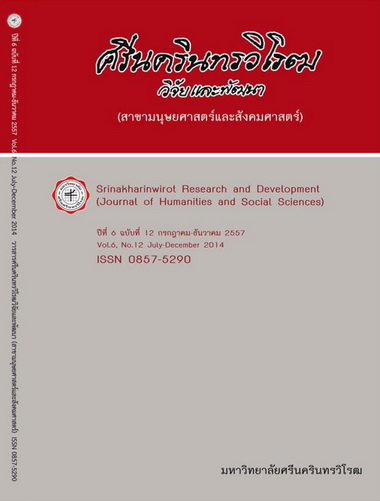ปัจจัยที่ส่งผลต่อพฤติกรรมการรังแกของนักเรียนโรงเรียนเอกชนสอนศาสนาอิสลามในจังหวัดสงขลา (FACTORS RELATED TO STUDENTS’ BULLYING BEHAVIOR IN ISLAMIC PRIVATE SCHOOLS, SONGKHLA PROVINCE)
Keywords:
Bullying Behaviors, Islamic Private Schools, Logistic Regression, Odds RatioAbstract
บทคัดย่อ การวิจัยในครั้งนี้มีวัตถุประสงค์เพื่อศึกษาปัจจัยที่ส่งผลต่อพฤติกรรมการรังแกของนักเรียนโรงเรียนเอกชนสอนศาสนาอิสลามในจังหวัดสงขลา โดยเก็บข้อมูลจากกลุ่มตัวอย่าง จำนวน 1,950 คน และวิเคราะห์ข้อมูลโดยใช้คอมพิวเตอร์โปรแกรมอาร์ เพื่อวิเคราะห์หาความสัมพันธ์ระหว่างพฤติกรรมการรังแกกับปัจจัยคุณลักษณะทางจิต การอบรมเลี้ยงดูของครอบครัว และอิทธิพลความรุนแรงโดยใช้การทดสอบไค-สแควร์ และวิเคราะห์ หาปัจจัยที่ส่งผลต่อพฤติกรรมการรังแกของนักเรียนโดยใช้การถดถอยลอจีสติค
ผลการวิจัยมีดังนี้
1. นักเรียนโรงเรียนเอกชนสอนศาสนาอิสลามในจังหวัดสงขลามีพฤติกรรมการรังแกจำนวนร้อยละ 37.9
2. ความคับข้องใจ การอบรมเลี้ยงดูแบบเข้มงวดกวดขัน อิทธิพลความรุนแรงจากสื่อโทรทัศน์ อิทธิพลความรุนแรงจากเกม และอิทธิพลความรุนแรงจากบิดามารดามีความสัมพันธ์กับพฤติกรรมการรังแกของนักเรียนโรงเรียนเอกชนสอนศาสนาอิสลามในจังหวัดสงขลาอย่างมีนัยสำคัญทางสถิติที่ระดับ 0.001
3. ปัจจัยที่ส่งผลต่อพฤติกรรมการรังแกของนักเรียนโรงเรียนเอกชนสอนศาสนาอิสลามในจังหวัดสงขลาอย่างมีนัยสำคัญทางสถิติที่ระดับ 0.001 มี 6 ตัวแปร ได้แก่ ความคับข้องใจ การอบรมเลี้ยงดูแบบเข้มงวดกวดขัน อิทธิพลความรุนแรงจากเพื่อน อิทธิพลความรุนแรงจากสื่อโทรทัศน์ อิทธิพลความรุนแรงจากเกม และอิทธิพลความรุนแรงจากบิดามารดา โดยกลุ่มนักเรียนที่มีโอกาสมีพฤติกรรมการรังแกสูง ได้แก่ นักเรียนที่มีความคับข้องใจในระดับมาก (1.60 เท่า) นักเรียนที่ได้รับการอบรมเลี้ยงดูแบบเข้มงวดกวดขันในระดับมาก (1.74 เท่า) นักเรียนที่ได้รับอิทธิพลความรุนแรงจากเพื่อนในระดับมาก (2.88 เท่า) นักเรียนที่ได้รับอิทธิพลความรุนแรงจากสื่อโทรทัศน์ในระดับมาก (3.66 เท่า) นักเรียนที่ได้รับอิทธิพลความรุนแรงจากเกมในระดับมาก (2.23 เท่า) และนักเรียนที่ได้รับอิทธิพลความรุนแรงจากบิดามารดาในระดับมาก (2.26 เท่า) และระดับปานกลาง (2.23 เท่า)
Abstract
The objective of this research was to study the factors related to students’ bullying behaviors in Islamic private schools, Songkhla provinces. The research collected data by interviewing 1,950 students, and using R computer program in analyzing chi-square test and logistic regression coefficient. Chi-square test was used to analyze the associations between the bullying behaviors and various determinants linked to affective characteristics, family upbringing, and violence influence. Logistic regression was used to analyze the factors related to students’ bullying behaviors.
The results of the research are as follow:
1. Thirty seven point nine percent of students in the Islamic private schools, Songkhla provinces reported having bullying behaviors.
2. The frustration, strict upbringing, influence of television violence, influence of game violence, and influence of parental violence were statistically significant associated at 0.001 levels with students’ bullying behaviors in Islamic private schools, Songkhla provinces.
3. There were 6 factors that were statistically significant associations at 0.001 levels with students’ bullying behaviors in Islamic private schools, Songkhla provinces which included the frustration, strict upbringing, influence of peer violence, influence of television violence, influence of game violence, and influence of parental violence. The students that were more likely to expresses bullying behavior were those who were high level of the frustration (1.60 times), who were high level of the strict upbringing (1.74 times), who reported high level of influence of peer violence (2.88 times), who reported high level of influence of television violence (3.66 times), who reported high level of influence of game violence (2.23 times), and who reported high and moderate level of influence of parental violence (2.26 times and 2.23 times).
Downloads
Downloads
Published
How to Cite
Issue
Section
License
Srinakharinwirot Research and Development Journal of Humanities and Social Sciences is licensed Under a Creative Commons Attribution-NonCommercial-NoDerivs 4.0 International (CC-BY-NC-ND 4.0) License, Unless Otherwise Stated. Please Read Journal Policies Page for More Information on Open Access, Copyright and Permissions.



